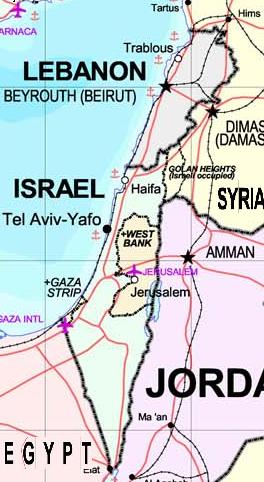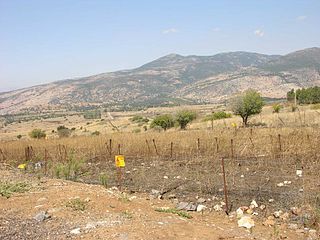This timeline of the Israeli–Palestinian conflict lists events from 1948 to the present. The Israeli–Palestinian conflict emerged from intercommunal conflict in Mandatory Palestine between Palestinian Jews and Arabs, often described as the background to the Israeli–Palestinian conflict. The conflict in its modern phase evolved since the declaration of the State of Israel on May 14, 1948 and consequent intervention of Arab armies on behalf of the Palestinian Arabs.
The International Solidarity Movement is a Palestinian-led movement focused on assisting the Palestinian cause in the Israeli–Palestinian conflict. ISM is dedicated to the use of nonviolent protests and methods only. The organization calls on civilians from around the world to participate in acts of nonviolent protests against the Israeli military in the West Bank and the Gaza Strip.

The Blue Line is a demarcation line dividing Lebanon from Israel and the Golan Heights. It was published by the United Nations on 7 June 2000 for the purposes of determining whether Israel had fully withdrawn from Lebanon. It has been described as: "temporary" and "not a border, but a “line of withdrawal”. It is the subject of an ongoing border dispute between Israel, Lebabon, and Hezbollah.

Rosh HaNikra or Hanikra is a geologic formation on the border between Israel and Lebanon, located on the coast of the Mediterranean Sea, in the Western Galilee. It is a white chalk cliff face which opens up into spectacular grottos.

Rosh HaNikra is a kibbutz in northern Israel. Located on the Mediterranean coast near the Rosh HaNikra grottoes and the border with Lebanon, it falls under the jurisdiction of Mateh Asher Regional Council. In 2022 it had a population of 1,422.
This is a timeline of events related to the 2006 Lebanon War.
Military operations of the 2006 Lebanon War refer to armed engagements initiated by Israel and Lebanese Hezbollah during the 2006 conflict.

The Israeli–Lebanese conflict, or the South Lebanon conflict, is a series of military clashes involving Israel, Lebanon and Syria, the Palestine Liberation Organization, as well as various militias and Militants acting from within Lebanon. The conflict peaked in the 1980s, during the Lebanese Civil War, and has abated since.

The 2006 Hezbollah cross-border raid was a cross-border attack carried out by Lebanon-based Hezbollah militants on an Israeli military patrol on 12 July 2006 on Israeli territory.

The 2006 Lebanon War, also called the 2006 Israel–Hezbollah War and known in Lebanon as the July War and in Israel as the Second Lebanon War, was a 34-day military conflict in Lebanon, northern Israel and the Golan Heights. The principal parties were Hezbollah paramilitary forces and the Israel Defense Forces (IDF). The conflict started on 12 July 2006, and continued until a United Nations-brokered ceasefire went into effect in the morning on 14 August 2006, though it formally ended on 8 September 2006 when Israel lifted its naval blockade of Lebanon. Due to unprecedented Iranian military support to Hezbollah before and during the war, some consider it the first round of the Iran–Israel proxy conflict, rather than a continuation of the Arab–Israeli conflict.

The 2000–2006 Shebaa Farms conflict was a low-level border conflict between Israel and Hezbollah for control of Shebaa Farms, a disputed territory located on the Golan Heights–Lebanon border. Fighting between the two sides primarily consisted of Hezbollah rocket and mortar attacks on Israel and Israeli artillery barrages and airstrikes on Hezbollah in southern Lebanon. Clashes began a few months after the 2000 Israeli withdrawal from Lebanon, which Hezbollah viewed as incomplete due to the presence of the Israel Defense Forces in Shebaa Farms. The conflict culminated in the 2006 Lebanon War; Israel retains control over the territory.

Israeli casualties of war, in addition to those of Israel's nine major wars, include 9,745 soldiers and security forces personnel killed in "miscellaneous engagements and terrorist attacks", which includes security forces members killed during military operations, by fighting crime, natural disasters, diseases, traffic or labor accidents and disabled veterans whose disabilities contributed to their deaths. Between 1948 and 1997, 20,093 Israeli soldiers were killed in combat, 75,000 Israelis were wounded, and nearly 100,000 Israelis were considered disabled army veterans. On the other hand, in 2010 Yom Hazikaron, Israel honored the memory of 22,684 Israeli soldiers and pre-Israeli Palestinian Jews killed since 1860 in the line of duty for the independence, preservation and protection of the nation, and 3,971 civilian terror victims. The memorial roll, in addition to IDF members deceased, also include fallen members of the Shin Bet security service, the Mossad intelligence service, the Israel Police, the Border Police, the Israel Prisons Service, other Israeli security forces, the pre-state Jewish underground, and the Jewish Brigade and the Jewish Legion.

The Rosh HaNikra Crossing also known as Ras Al Naqoura Crossing is an international border crossing between Naqoura, Lebanon and Rosh HaNikra, Israel. The terminal is operated solely by the United Nations Interim Force in Lebanon and the Israel Defense Forces. The passage of regular tourists/visitors is forbidden.
Events in the year 2010 in Israel.

Several incidents have taken place on the Israeli–Syrian ceasefire line during the Syrian Civil War, straining the relations between the countries. The incidents are considered a spillover of the Quneitra Governorate clashes since 2012 and later incidents between Syrian Army and the rebels, ongoing on the Syrian-controlled side of the Golan and the Golan Neutral Zone and the Hezbollah involvement in the Syrian Civil War. Through the incidents, which began in late 2012, as of mid-2014, one Israeli civilian was killed and at least 4 soldiers wounded; on the Syrian-controlled side, it is estimated that at least ten soldiers were killed, as well as two unidentified militants, who were identified near Ein Zivan on Golan Heights.

As a response to an Israeli attack against a military convoy comprising Hezbollah and Iranian officers on January 18, 2015 at Quneitra in southern Syria, the Lebanese Hezbollah group launched an ambush on January 28 against an Israeli military convoy in the Israeli-occupied Shebaa Farms, firing anti-tank missiles against two Israeli Humvees patrolling the border, destroying the two Humvees and killing 2 and wounding 7 Israeli soldiers, according to Israeli military. The number of Israeli casualties was 15 according to a report by Al Mayadeen television station. A Spanish UN peacekeeper was also killed by Israeli fire during consequent fire exchanges in the area, with Israel firing artillery and Hezbollah responding by mortar shells. The conflict ended later the same day after UNIFIL mediation.
List of violent events related to the Israeli-Palestinian conflict occurring in the second half of 2015.
This is a Timeline of events related to the Israeli–Palestinian conflict during 2016.
This is a chronological timeline of the Israel–Hezbollah conflict since October 2023.










